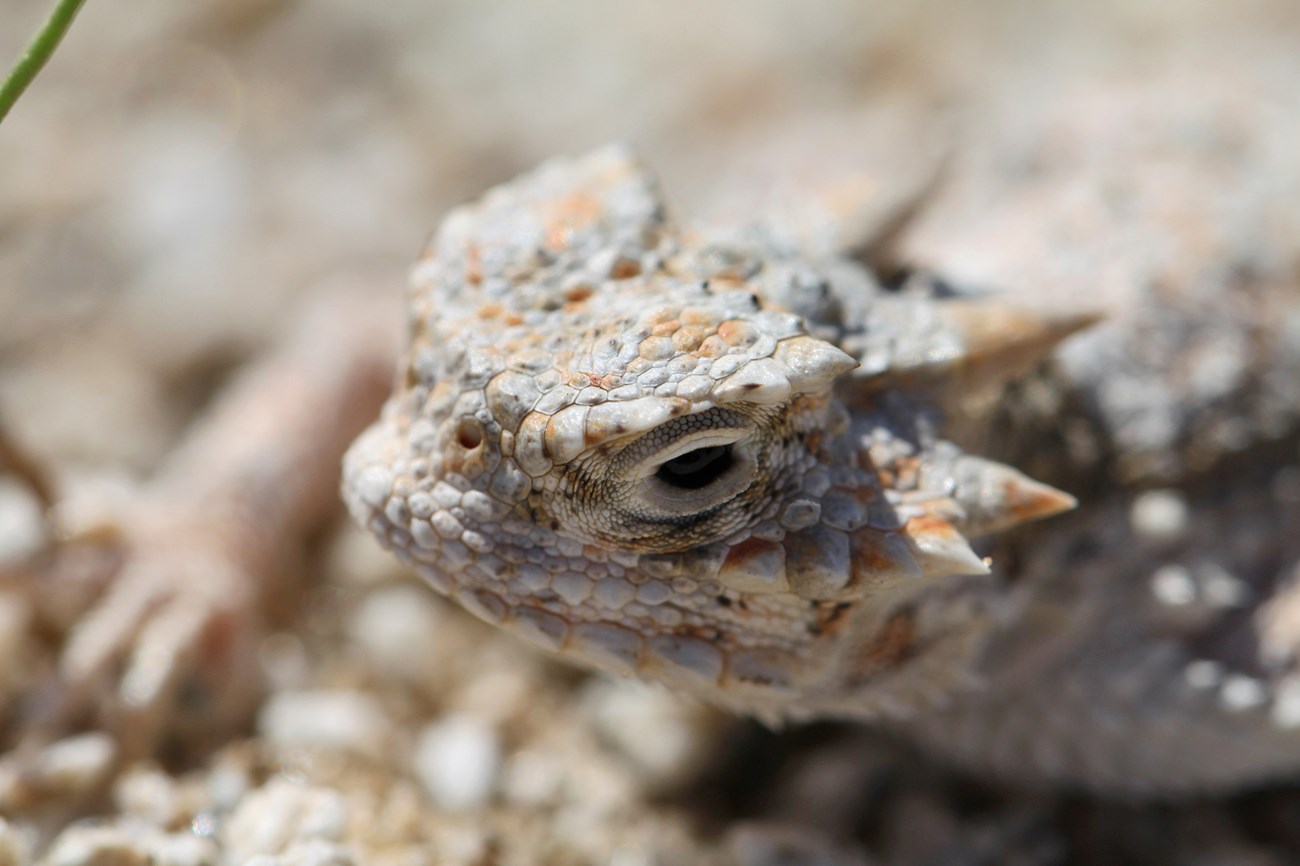Tortoise
|
Mojave Desert Tortoise
Gopherus agassizii |
Creosote bush lowlands in the Mojave Desert. Rocky hillsides and bajadas in the Colorado Desert. |
threatened |
Lizards
|
Woodland Alligator Lizard
Elgaria multicarinata webbii |
Prefers moderately damp areas; northwest section |
rare |
San Diegan Legless Lizard
Anniella stebbinsi |
Sandy or loose loamy soils with some moisture; northwest section |
special concern |
Great Basin Collared Lizard
Crotaphytus bicinctores |
Rocky slopes, rock outcrops of gullies, and boulder-strewn alluvial fans |
common |
Long-nosed Leopard Lizard
Gambelia wislizenii |
Open sandy or gravelly flats and plains; less commonly in rocky areas |
common |
Desert Banded Gecko
Coleonyx variegatus variegatus |
Most common in sandy flats; occasional in canyons and rocky areas |
common |
Desert Iguana
Dipsosaurus dorsalis |
Most common on sandy flats, dunes, and washes but also along rocky washes and on alluvial fans |
common |
Common Chuckwalla
Sauromalus ater |
Rocky outcrops, rocky canyons, rocky slopes, and alluvial fans |
special concern |
Western Zebra-tailed Lizard
Callisaurus draconoides rhodostictus |
Open areas of sandy and gravelly desert flats, sandy washes, and alluvial fans |
common |
Blainville's Horned Lizard
Phrynosoma blainvillii |
Northwest section where loose, fine soil with high sand content is present |
special concern |
Southern Desert Horned Lizard
Phrynosoma platyrhinos calidiarum |
Sandy flats and canyon bottoms |
common |
Desert Spiny Lizard
Sceloporus magister |
Most abundant in the Joshua tree woodland. Occasionally on rock outcrops. |
common |
Great Basin Fence Lizard
Sceloporus occidentalis longipes |
Rocky outcrops above 3,000 feet. |
common |
Yellow-backed Spiny Lizard
Sceloporus uniformis |
Most abundant in the Joshua tree woodland. Occasionally on rock outcrops. |
common |
Mojave Fringe-toed Lizard
Uma scoparia |
Wind-blown sand of dry lake beds, washes, and large dunes |
special concern |
Western Long-tailed Brush Lizard
Urosaurus graciosus graciosus |
Bushes and small trees; also in clumps of galleta grass, Pleuraphis rigida |
common |
Western Side-blotched Lizard
Uta stansburiana elegans |
Open, sunny ground. Usually some rocks and loose soil are present. |
common |
Western Red-tailed Skink
Plestiodon gilberti rubricaudatus |
Prefers moderately damp areas; northwest section |
common |
Great Basin Whiptail
Aspidoscelis tigris tigris |
Most common in areas where vegetation is densest |
common |
Desert Night Lizard
Xantusia vigilis |
Most common in Joshua tree woodland, especially within fallen branches of Joshua trees and yuccas. |
common |
Snakes
|
Rosy Boa
Lichanura orcutti |
Rocky hills and canyons |
special concern |
Mojave Glossy Snake
Arizona elegans candida |
Prefers sandy areas, but also occurs on hard pan or in rocky areas; northern section |
common |
Desert Glossy Snake
Arizona elegans eburnata |
Sandy flats; southern section |
common |
Mojave Shovel-nosed Snake
Chionactis occipitalis |
Sandy desert, creosote busy, and dune areas. Occasionally in rocky canyons and on rocky slopes. |
common |
Red Racer
Coluber flagellum piceus |
Prefers open areas with high visibility. |
common |
California Striped Racer
Coluber lateralis lateralis |
Most common in pinyon-juniper woodland; northwest section |
common |
Northern Desert Nightsnake
Hypsiglena chlorophaea deserticola |
Most common in rocky areas |
common |
California Kingsnake
Lampropeltis californiae |
Found in all communities; most common in canyons with water. |
common |
Spotted Leaf-nosed Snake
Phyllorhynchus decurtatus |
Areas of mixed sandy and rocky soil |
common |
Sonoran Gophersnake
Pituophis catenifer affinis |
Creosote bush scrub; southern section |
common |
Great Basin Gophersnake
Pituophis catenifer deserticola |
Creosote bush scrub, pinyon-juniper, and Joshua tree woodlands, desert riparian community; northern section. |
common |
Long-nosed Snake
Rhinocheilus lecontei |
Creosote bush and pinyon-juniper woodlands |
common |
Desert Patch-nosed Snake
Salvadora hexalepis hexalepis |
Creosote bush scrub, desert washes; southern section |
rare |
Mojave Patch-nosed Snake
Salvadora hexalepis mojavensis |
Most common on sandy valley floors; northern section |
common |
Variable Groundsnake
Sonora semiannulata semiannulata |
Desert flats, sand hummocks, open rocky hillsides with loose soil, sandy washes, dry streambeds, and riparian thickets |
rare |
Smith's Black-headed Snake
Tantilla hobartsmithi |
Desert riparian, pinyon-juniper, and Joshua tree woodland; creosote bush and alkali scrubs; perennial grassland |
common |
California Lyresnake
Trimorphodon lyrophanes |
Rocky foothills, canyons, and mesas |
common |
Desert Threadsnake
Rena humilis cahuilae |
Sandy hills and rocky slopes where soil moisture is present; southern section |
common |
Southwestern Threadsnake
Rena humilis humilis |
Moist areas in canyons, rocky slopes, boulder piles, and among the roots of shrubs; northern section |
common |
Western Diamond-backed Rattlesnake
Crotalus atrox |
Areas with fairly thick vegetation; southern section |
common |
Mojave Desert Sidewinder
Crotalus cerastes cerastes |
Sandy deserts, occasionally in rocky areas |
common |
Colorado Desert Sidewinder
Crotalus cerastes laterorepens |
Sandy, south-facing canyons; southwestern section |
common |
Southwestern Speckled Rattlesnake
Crotalus mitchelli pyrrhus |
Rocky slopes, canyons, and rock outcrops |
common |
Southern Pacific Rattlesnake
Crotalus oreganus helleri |
Pinyon-juniper woodland communities; northwestern section |
common |
Red Diamond Rattlesnake
Crotalus ruber |
Brush shrouded granite boulders and cactus patches; western section |
common |
Northern Mojave Rattlesnake
Crotalus scutulatus scutulatus |
Desert flats; northwestern edge only |
common |

